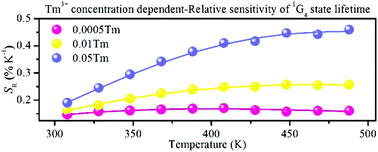Up-conversion luminescence lifetime thermometry based on the 1G4 state of Tm3+ modulated by cross relaxation processes†
Abstract
β-PbF2:Tm3+/Yb3+ glass ceramics (GCs) with varied Tm3+ doped concentrations were synthesized by the conventional melting-quenching method and the subsequent glass crystallization route. For the first time, the lifetime-based thermometer based on up-conversion luminescence (UCL) originating from the 1G4 state excited upon a miniaturized 976 nm diode laser excitation in β-PbF2:Tm3+/Yb3+ GCs is achieved. Furthermore, the thermosensitivity of the 1G4 state lifetime is realized by the phonon-assisted cross relaxation (CR) processes between Tm3+ which depopulate the 1G4 state and get severer with temperature. The relative sensitivity (SR) of the 1G4 state lifetime is promoted by intensifying CR processes via raising Tm3+ concentration in this work. The maximum values of SR of 1G4 state lifetime obtained in 0.0005Tm, 0.01Tm and 0.05Tm are 0.16%K−1, 0.26%K−1, and 0.46%K−1 at 488 K, respectively, which indicates the potential ability of Tm3+-doped nanoparticles to work as indicators for UCL lifetime-based thermometers.



 Please wait while we load your content...
Please wait while we load your content...